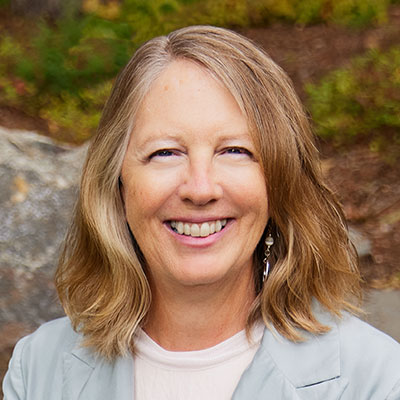I have been deathly afraid of being cold and wet at the same time for as long as I can remember. I’m not speaking hyperbolically, either. If someone asked why I needed two sweatshirts for a boating daytrip on a sunny 80-degree day I would respond, “what if one got wet? Then I would get cold.” If they pushed too hard on the logical front, they’d get the “I need them. I don’t want to die,” response. In addition, I hated getting my face wet, even in the shower.
I never thought much about this fear before becoming a bodyworker and starting my own healing journey. Aside from toting extra sweatshirts, pants, or coats with me whenever an activity involved water, it hadn’t impacted my daily function. After my recent study of trauma and PTSD, however, I know we speak some truth encapsulated in our nervous system when what we say or do makes little sense to those around us.
Somewhere, somehow, my survival brain developed the belief that being wet and cold at the same time would be fatal.
I’m still not 100% sure where this originated. It could be taking baths in an unheated bathroom until the age of 5. It could be my parents’ admonitions to stay dry when working outside in 30-below weather on the dairy farm, our few stubby-eared cows born during cold snaps a daily reminder of the dangers of frostbite. It could be I’d grown up in Colorado, without swim lessons or opportunities to become comfortable in water, let alone proficient in it. I joked I must have perished drowning in cold water in several previous lives. It wasn’t until I did a continuing education course in Biodynamic Craniosacral Therapy in 2016 that I added my ancestral lineage, or, in other words, intergenerational trauma, to the list.
One day in the BCST class our instructor ran a guided visualization where we were to submerge ourselves in water. I struggled, attempting time and again to follow her voice and immerse myself in the experience. Each time I failed. The instructor must have noticed my discomfort, because she mentioned we might have trouble with this exercise if there was a history of drowning in our family.
I had never personalized the terrible loss my mother and grandparents experienced long before I was born. It was never mentioned or acknowledged, except for the photo on my mother’s dresser. For 50+ years, if I spoke of it, I said, “my mother’s nephew drowned at 18 mos. in 2 inches of water in a bucket in my grandparent’s backyard 5 weeks after his mother died of polio.” I did not refer to this baby as my cousin. I did not refer to my mother’s sister as my aunt. I did not refer to any of them by name.
I detached from their tragedy. Except for the part of me that somehow knew water was deadly. Today I would bet the water in that bucket felt cold on Bobby’s face.
When my own children came into the world I vowed not to pass along my own fear. I married a water-loving Californian who joyfully leads his family into ponds, rivers, oceans, hot springs, and pools. Basically, if it’s wet, he wants to go in. He swims daily, if possible, and chooses vacation spots based on swimming opportunities. I signed the kids up for swim lessons before they could walk, observing, and practicing what they learned along with them. In 2008, I surprised everyone, most of all myself, by becoming underwater scuba certified. In 2010 I swam a very short open water charity event. In 2013 we moved to the oceans edge, and I began swimming to and from our boat. In winter, I added swimming with Jeff on Sundays at the YMCA pool, where he coached me on my technique. I rewarded my efforts there with an after-swimming stint in the sauna.
Still, I was deathly afraid of being wet and cold at the same time. Still, I packed extra sweatshirts for boat trips.
A few years ago our family started a new holiday tradition – a polar plunge. Christmas 2020 I fully dunked into the North Atlantic with them for the first time. I followed them in again on New Year’s Day. The other 3 members of my Covid-pod made a resolution to plunge weekly until summer. I was thus inspired to launch an experiment on myself.
Could I re-train my brain and release this forever fear by repeatedly surviving being wet and cold at the same time?
Week after week I plunged with them, not just my body, but all the way under, face included. They encouraged and supported me. They held me accountable. For the first 7 weeks I mandated after-photos, posting them, along with the air and water temps, on my social media. I texted the photos to my siblings. Similar to my daily blog posts when walking the Camino 8 years ago, the virtual support I received bolstered my confidence and dedication to keep going.

On March 4 something shifted. I looked out the window at the water and wanted to get in. I wanted it so badly I plunged alone. A few weeks later I ran a bath, and found it was too hot. I could not ever remember thinking water was too hot before.
In April my husband challenged us to see how long we could stay in. Could we swim, even for a few strokes? By the start of June, I was swimming short distances without a wetsuit. On June 3, I joined him and the rest of the Walden Polar Bears for an early morning swim. Several of them had signed up for a charity event on July 10; Jeff invited his fellow Covid plungers to participate. Due to various factors, it wasn’t until the day before that he and I made the commitment to attend – he would do the middle swim distance of 5km (3m) and I would do the shortest distance of 1km (.6m).
We arrived at the race venue at 6am. A cold wind was blowing off Newfound Lake right onto the beach, creating chop in the water. I shivered under my sweatshirt and pants, the thought of stripping down to my swimsuit beneath creating an old, familiar pain in my belly.
In addition, I had forgotten this was a fundraiser for military veterans. During the race briefing, the emcee announced there were drill sergeants in the safety boats and he took no responsibility for their particular type of encouragement. He introduced a number of notable people in attendance, including the Navy Seals. None of this was familiar territory, and I was sinking fast into outright distress.
I leaned over to Jeff and whispered, “of course, I’m trying to swim farther than I’ve ever swum before, in an event to boot, and I pick one that includes the frickin’ Navy Seals!”
On the verge of washing out, a few small items kept me from doing so. First and foremost, Jeff, my staunchest supporter, had faith in me. Second, some of the Walden Polar Bears were in attendance, each one cheering me on. Third, my athlete number was 1101, and my cap number was 373, all numbers I take as assurance from my angels and guides that they are present, giving me a heavenly “thumbs-up”, and shepherding me through.
I piled my clothes on the picnic table with the other Bears belongings, donned my cap and goggles and headed to the start line. I positioned myself in the rear of the group, following Jeff’s advise, to avoid being kicked in the head by other swimmers as much as possible.
At the start of the race, I was surprised by the water’s warmth, the current’s strength, and the fresh water’s lack of buoyancy. Contrary to the familiar ocean’s waves, the arrhythmic lake chop defied my novice form, seeming to delight in splashing water up my nose.
On the other hand, I was not surprised when all the other swimmers quickly outpaced me. After all, I’m primarily a breaststroker. In the past, being last in any sporting event would have triggered its own anxiety response, but this time I was able to reassure myself, again relying on lessons I learned walking the Camino. One step, or rather, one stroke at a time eventually leads you home.
Swimming was easier once I circuited the halfway buoy and was flowing with the current; the wind had ebbed as well. I was nearing the beach when I spied a swimmer coming toward me. I was befuddled. My group had been the last to leave the beach, there were no further waves of competitors. This person swam right up to me and asked if I’d like some company. By this time I was fatigued, starting to chill, and my target was in sight. I replied, “sure, but this is the only speed I’ve got.” He introduced himself as Jon and asked my name. All at once, my brain unfuddled enough to grasp the situation.
“You’re a Navy Seal.”
“Yes.”
He matched my floundering pace, giving us plenty of time for a lovely chat before I crossed the finish line, receiving my medal and a congratulatory “well done” from Jon. A celebratory hamburger and fries with Jeff and an afternoon spent with friends topped off the momentous day.
The best reward I could hope for, however, is that my experiment worked. I am no longer afraid of being wet and cold at the same time. No longer do I fear the water. I don’t like being wet and cold, and I’m still aware of the dangers of hypothermia, but miracle of miracles, I have fallen in love with swimming. Decades of immersion therapy + intentional action + community support has finally unraveled whatever was held in my body.
“When you do the work for one, you do the work for all,” my guides reminded me several months ago.
The Tuesday after I completed my swimming race my sister texted me. She and her family have been watching over the property in Colorado my grandparents bought 60 years ago that now belongs to me. She sent me a photo of a tree with a large dead branch hanging over the old road, impeding them from moving around freely, asking permission to remove it.
I said yes.
You truly can’t make this stuff up.
Swim with a Mission raises money to help provide service dogs, therapeutic programs and other adjunct support for our veterans.
Donations are appreciated.
For those who are working through their own “stuff,” you may find this body-centered video helpful.

